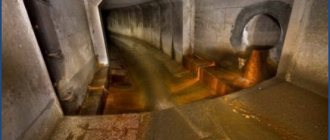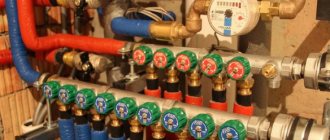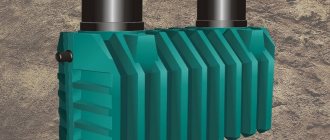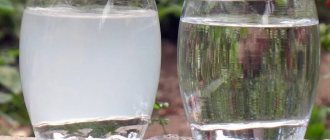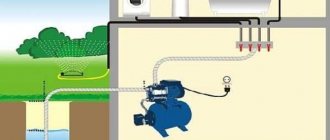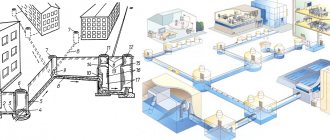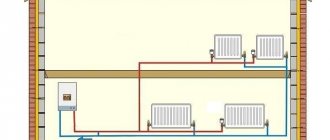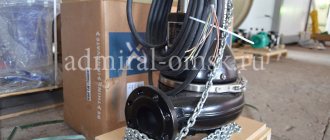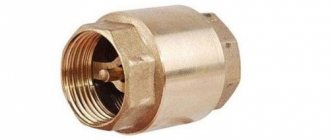In this article, I will tell you how to correctly install the collector distribution of water supply pipes in an apartment. What causes water hammer, why does the temperature drop in the shower and how to do everything correctly so that you don’t have anything like this.
This article will be useful to those who are planning to install water supply pipes in an apartment with their own hands and do not yet know where to start, as well as to those who have purchased an apartment in a new building and plan to make high-quality repairs and a reliable water supply system there.
Not all craftsmen who undertake turnkey renovations in an apartment will be at all concerned about the correct installation of the water supply. For many, the main thing is to make the price tag cheaper than others and how everything will be done fades into the background.
Definition of the term “collector”
Water in the house always flows into the bathroom and kitchen. However, they still cannot do without it in a bathhouse, swimming pool, sauna, shower, and so on. Water supply must be ensured for all consumers, which are, for example, a sink, toilet, dishwasher and washing machine.
The water collector is a technical element. This part of the indoor water supply network is also called the comb. It is installed at the beginning of the system with cold and/or hot water. The installation of this important element is carried out, for example, in the boiler room of a private house or in a room where water treatment is carried out.
When choosing the installation location, free access to the water collector is ensured. It should not subsequently be cluttered with furniture and other objects. The comb cannot be tightly sewn into the building structures of the house. Often such a technical element is covered with a decorative false panel to improve the plumbing unit.
The presence of a collector in the water supply system of a house allows water to be delivered to each water distribution point. Their number is individual in all private residential buildings.
Mounted collectors in a private residential building Source oventrop-home.ru
A simplified version is two sinks, a bathtub and a toilet. Although modern houses have several toilets and bathrooms. Many homeowners combine such premises and install a large number of additional household devices, the operation of which is carried out only after connecting to the water supply.
Design and principle of operation of the collector
The main function of the comb collector is to distribute water to all plumbing fixtures. With the help of this element, the total flow is distributed into several parts that will not differ in pressure.
Manufacturers make combs with multiple outlets. Their number ranges from 2 to 4 pieces. When it is necessary to distribute water to more devices, then the devices are connected to each other. In this case, they focus on the required number of branches. If there are more of them, then unnecessary outlets are closed with plugs.
Comb with three branches Source leroymerlin.ru
The comb is made in the shape of a cylinder. Therefore, a collector is a pipeline whose diameter is larger than the cross-section of the connected pipes. At one end of this plumbing device there is an internal thread, and on the other side there is an external thread. This design allows the combs to be interconnected and connected to a supply line with hot or cold water.
The free end of the plumbing fixture is closed with a plug or an additional device is installed in this place. This is, for example, a device to prevent water hammer.
The cross-section of the comb inlet is always larger by 20% or even 40% of the diameters of the branches. Distribution devices with 3/4 inch inlet are often installed. Moreover, their outlets are 1/2 inch in size.
It is possible to mount a water supply manifold, whose outlet openings are equipped with taps or valve mechanisms. Both options allow you to shut off the flow in each branch. Using valves, you can also regulate the water supply power.
Water distribution device with four valves Source feko.com.ua
See also: Catalog of companies that specialize in water supply, sewerage and related work
Advantages of installing a collector device
Distributing water to each consumer according to the classical scheme using tees is cheaper than collecting water pipes. However, the use of combs has a number of advantages.
Distribution devices allow you to regulate the pressure in each branch. If you install a water supply system according to the classical scheme, then a decrease in pressure often occurs in an open mixer, for example, above a bathtub. This situation can occur when someone in the house uses the toilet, washes dishes in the kitchen sink, or turns on the washing machine.
The pressure difference will cause a change in water temperature. This leads to discomfort while taking a bath. A person can even get burned due to the increase in water temperature. A water collector for plumbing helps to avoid situations. It prevents pressure drops in the home system.
The use of a comb collector reduces the likelihood of a sharp change in water temperature in an open tap Source 299999.ru
Combs with valve mechanisms on the branches to regulate the water supply in each branch allow you to repair faulty plumbing fixtures. In this case, there is no need to shut off the entire water supply system.
The use of comb collectors also allows you to reduce the number of joints in the water supply. Thanks to this wiring scheme, the likelihood of leaks in the house is reduced. After all, a single pipeline can be laid from the collector to each water collection point.
In addition, combs allow you to quickly install additional plumbing if necessary. In this case, there is no need to redo the existing system.
However, the collector distribution of water supply pipes is characterized by high consumption of materials. Its implementation requires almost 8 or even 10 times more pipelines than for installing a water supply system according to the classical scheme. To reduce the cost of creating such a system, it is recommended to use pipes made of metal-plastic or polypropylene.
If there are collectors, separate water pipes are supplied to all plumbing fixtures Source kotel02.ru
Types of water supply pipes
The main types of pipes used in organizing water supply:
- Copper pipes connected using special solders. The lines are resistant to corrosion and can withstand heating up to 250°C. Pipes are elastic, which allows you to create pipelines of complex configurations. The disadvantage of the material is the formation of a galvanic couple upon contact with aluminum or steel elements. When used in multi-storey buildings, one should take into account the high current conductivity; if the neighbors’ equipment breaks down, the pipeline becomes energized.
- Metal-plastic pipes consisting of several layers of plastic with an aluminum gasket. The products are highly elastic; threaded bushings or crimp elements are used for connection. The products are not used for hidden installations, since the rubber seals at the joints lose their elasticity and allow water to pass through. The advantage is the absence of corrosion; the smooth internal surface prevents the formation of deposits.
- Products made of polybutylene that can withstand heating up to 90°C. The elements are connected using soldering technology, the seam is characterized by increased strength. Due to the high cost, polybutylene products are not widely used; the pipes are used in the construction of heated floors.
- Polyethylene reinforced pipes designed for pressure up to 3.5 atm. Use in water supply networks is not recommended, since the material is not highly durable. The parts are used for distributing water in personal plots or in domestic buildings; the material allows the liquid to freeze. When connecting, it is necessary to install a reducer that reduces the pressure of the water flow to a safe level.
- The lines are made of polyvinyl chloride, which is characterized by high chemical resistance and allows operation at temperatures up to 80°C. The disadvantage of the material is its low resistance to ultraviolet radiation. Soldering or glue is used to connect pipe fragments, but the strength of the joint does not allow water to be supplied under pressure above 3.5 atm. Pipes are used for water supply to technological premises or when organizing irrigation systems; a reducer is provided in the main line to reduce pressure.
- Pipes made of polyisopropylene, allowing elements to be connected by soldering. The material is low cost and allows pressure up to 12 atm. and temperature up to 130°C. The surface of the pipes is rough, but plaque does not form in the inside of the lines. The products are used for organizing risers and for distributing water inside residential or office premises.
When selecting pipes, you should take into account the cross-section of the internal channel, on which the throughput depends. To determine the parameter, it is necessary to find out the required pressure in the lines; the coefficient of pressure drop inside the pipe and at the joints is taken into account. When planning the laying scheme, straight sections should be used, but excessive lengthening and cluttering the branch with reinforcement lead to a drop in pressure.
Classification of distribution manifolds
Manufacturers produce combs from various materials. They differ in design. Currently available on the market:
- Stainless steel devices that are lightweight, corrosion resistant, and able to withstand high temperatures and open flames. The attractive steel used does not pose any danger to humans.
- Polypropylene lightweight devices that do not rust.
- Durable brass combs are corrosion-resistant plumbing elements. They are expensive, but allow you to distribute even very hot water.
Manufacturers produce comb collectors in which the center-to-center distance between branches can range from 36 to 100 mm. The devices also differ in the way the pipes are connected to the branches. There are several options:
- thread;
- eurocone - for connecting most types of pipes through a special adapter;
- polypropylene bends - intended for soldering pipelines made of the same material;
- compression fittings - allow you to connect metal-plastic pipes.
Manifold with compression fittings Source bavariaplus-remont.ru
Leak protection system
Even the most reliable and modern water supply system includes connections with sealing gaskets and flexible hoses. According to statistics from insurance companies, these elements are the main causes of leaks in the apartment.
In order to protect yourself, you need to install a leakage protection system. The system consists of a ball valve with a servo drive, a control module and sensors. When water hits the sensor, the system gives a command to close the tap.
It is important to note that the leakage protection system should be installed immediately after the shut-off valve - this will help minimize the number of unprotected connections.
Read more about the leakage protection system >>
There are a large number of protection systems on the market, but our company recommends installing the Akvastorozh system. It has proven itself well, and the manufacturer provides good, timely service.
Cranes and other components
When choosing a collector for water supply, professionals will always help you determine which is best from the existing range. Specialists will take into account the allocated budget and the material of the pipes from which the wiring in the house will be created. In addition, simultaneously with the comb, all components are selected to create a full-fledged distribution unit of the water supply system:
- valves;
- pressure gauges;
- pumps;
- valves;
- fasteners;
- plugs;
- couplings;
- filters;
- counters;
- fittings.
Manufacturers also produce manifold cabinets. They are built into the wall or mounted on its surface. Their use allows you to improve the distribution unit and provide free access to it.
Combs are produced with and without taps. When using the latter option, you still have to install shut-off valves, but they can always be replaced when a breakdown occurs. If you choose a collector with built-in taps, you will have to completely change the distribution element of the water supply system.
Manifold-comb without taps on taps Source komsis.su
Products on the market
Depending on the material, the cost of products ranges from 400 to 2500 rubles. Collector groups for 200-300 outputs can cost 10,000-40,000 rubles.
There are models from different manufacturers on the market, the popular ones include:
- Watts;
- Uponor;
- Giacomini;
- APC;
- Luxor;
- Fado;
- Caleffi;
- Valtec;
- Bianchi.
The stores offer not only combs, but also accessories. Products without taps are economical. They are used to install individual wiring and make it possible to select suitable parts. Purchasing a product with shut-off valves will make the installation process easier. When assembling the units, the need to install valves disappears.
To adapt the device to the home system, components are purchased. These include valves, valves, and pump groups. Mechanical drives, plugs and pipes are required.
Manifold cabinets are used for wall mounting and maintaining an aesthetic appearance.
Installation Features
Before installation work, professionals always first determine:
- Number of consumers. The number of outlets on the comb may be greater, but not less than the water points.
- Type (material) of pipes to each device.
- Installation locations for additional components of the distribution unit. Their attachment points are marked on the wall.
- Necessary consumables and their quantities.
The collector installation process itself is carried out in stages:
- install shut-off valves on the inlet line;
- install check valves, meters and filter elements;
- connect and secure the switchgear;
- lay pipes to each water point;
- connect pipelines to the collector.
All work can be performed with high quality only by professionals. The whole process takes more time than installing a water supply according to the classical scheme.
Installation rules
Collector water supply scheme
You can do the wiring of the water supply network with the installation of the collector yourself. It is assembled according to this scheme: the main pipe is connected to the comb directly, without any branches. Pipes supplying water to each plumbing fixture are connected to it. The devices are conveniently installed behind the toilet flush cistern. But other versions are also acceptable.
To choose a location for the comb, take into account:
- accessibility for repair and installation;
- humidity (moderate);
- the presence of a load-bearing wall on which the device is fixed;
- the ability to work in case of an accident at any time of the day thanks to additional lighting.
Sometimes the device is installed in a separate room or closet. To secure the collector, special clamps are used.
Combs are installed for both hot and cold water supply. For ease of use and to avoid confusion, manufacturers produce collectors in two shades: red and blue.
The installation should be carried out only after the wiring has been installed, meters, check valves, filters and other parts of the water line have been installed. At the connection point to the main riser, the system is equipped with ball valves that shut off the main flow. There is also a coarse filter and a meter that allows you to control water consumption.
It will be necessary to complete the installation of water lines for each point of consumption. To do this, it is worth leaving free outlets in the collector, plugging them with plumbing plugs. Only after this can the unit responsible for distribution be installed. Install it without additional sealing.
Carrying out installation in this order will reduce the load on the connections and help avoid their deformation. This is especially true for non-professionals.
When installing, you need to take into account the following points:
- The device responsible for distribution is certainly equipped with shut-off elements for adjusting and shutting off the flow.
- The cross-section of the connection point to the main line must be larger than the standard 15 mm. This diameter of the inlet pipe makes it possible to provide the consumer with the required amount of water while simultaneously using several plumbing fixtures.
- To neutralize water hammer, which can cause serious damage to the water supply, you need to install a special damper.
- Adapter fittings are installed on the threaded connection of the valves or the outlets from the manifold. Pipes supplying water to points of consumption are connected to them.
- When equipping a building with two or more floors with water supply, it may be necessary to install a circulation pump.
If a hidden water distribution system scheme is chosen, you will need to install thermal insulation material on the supply pipes. This method allows you to avoid cracking of the screed or the places where the grooves are sealed. Heat loss in the hot water supply pipeline will also be reduced.
Briefly about the main thing
The manifold is used to distribute the flow evenly to each plumbing fixture. At the same time, the pressure remains constant, even if the flow of hot or cold water unexpectedly increases.
Combs are made of brass, stainless steel and polypropylene. They look like a pipeline with an increased diameter. It is equipped with several outlets with or without taps. The presence of shut-off valves allows you to turn off one of the water points at any time in order to carry out repairs. At the same time, in all other premises water can be used without restrictions.
The installation of the collector is carried out after installing the valve, meter, filter and shut-off valves on the inlet line. A fixed comb is connected to pipelines to each water point.
Ratings 0
